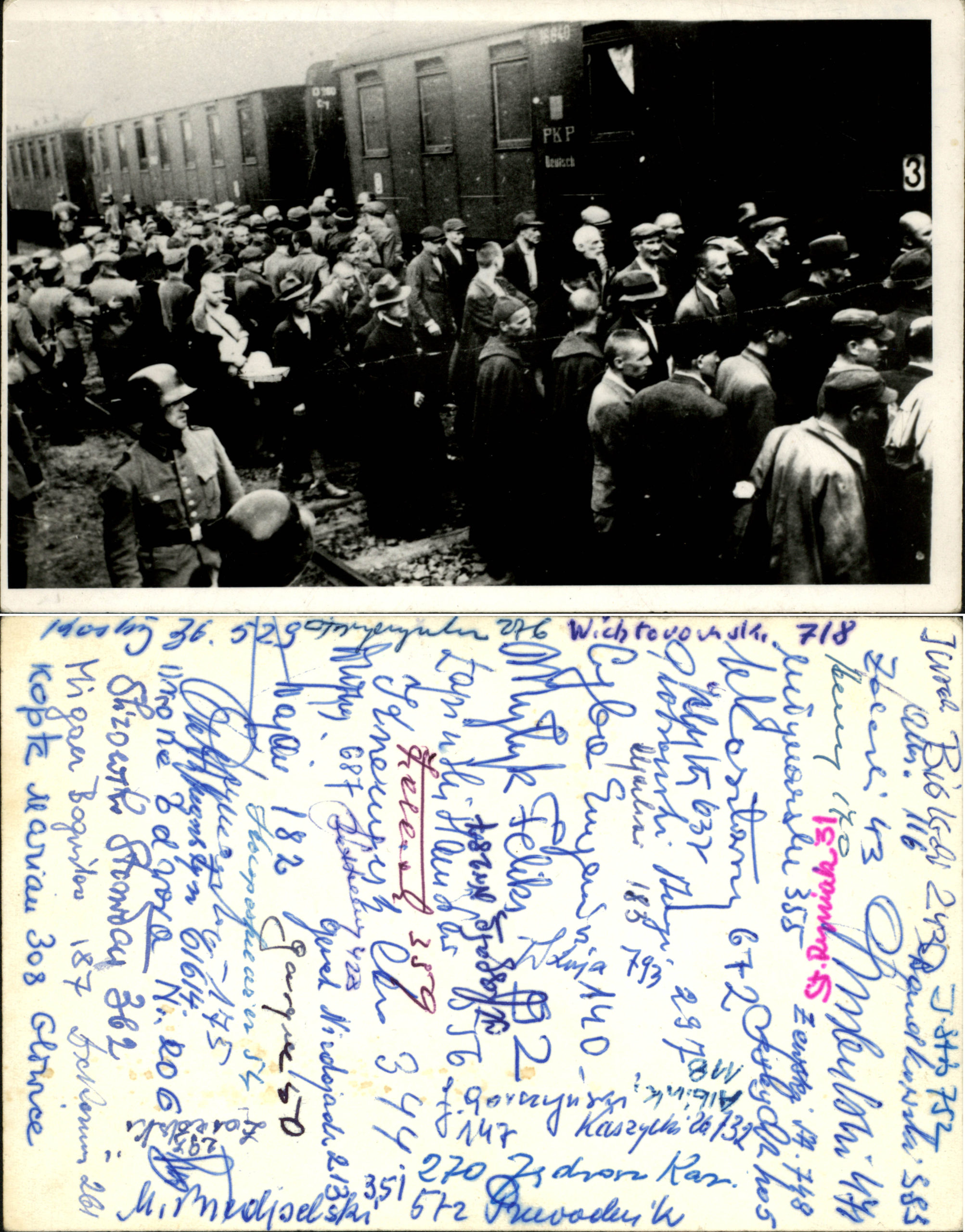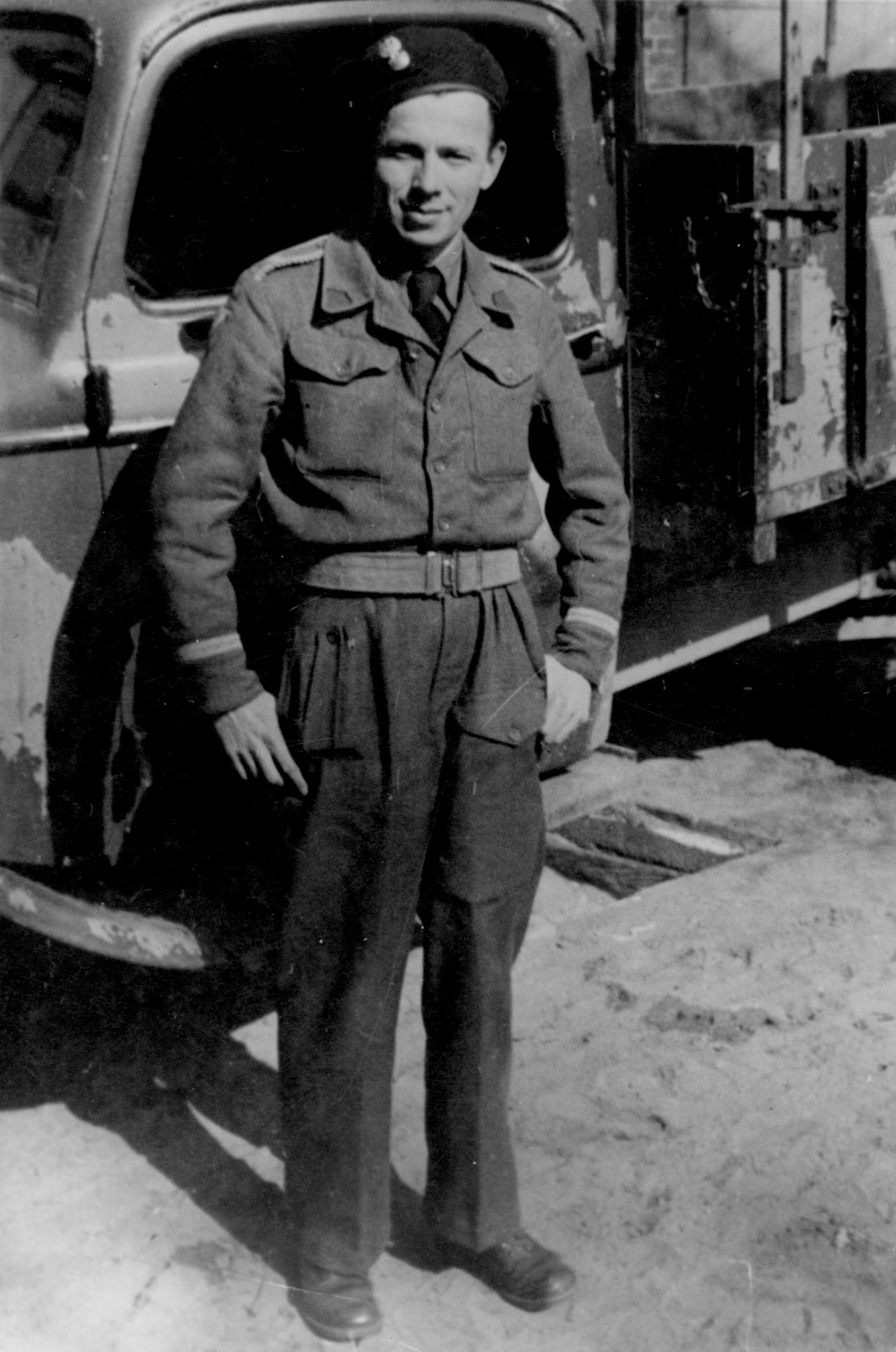A Prisoner of the Very First Transport to KL Auschwitz
Category
Death Camps
Donated by
Gabriela Grabowska
Signature
IPN Kr 875

Copy of a photograph showing the loading of prisoners on trains for the very first transport to KL Auschwitz (Tarnów, June 14, 1940). On the back of the photo are signatures of the prisoners from this transport, collected after WWII
A clerk, a soldier, a teacher, and camp number 112
Aleksander Kołodziejczyk was born on January 21, 1914 in Krakow, the son of Feliks and Stanisława, neé Woźniakowska. In the interwar period he worked in the Tax Office at 7 Wiślna St. in Krakow, and was a board member of the Krakow branch of the Tax Office Workers Association (Zarząd Krakowski Koła Związku Zawodowego Pracowników Skarbowych). He was also active in the Polish Socialist Party. In the years 1937–1938, he attended the Volhynia Artillery Reserve Cadet School named after Marcin Kątcki (Wołyńskiej Szkole Podchorążych Rezerwy Artylerii im. Marcina Kątskiego), located in the Włodzimierz Wołyński garrison. Among the archival materials loaned to IPN, we can find a photograph showing a lesson in military topography, dated February 16, 1938.
On the basis of a secret mobilization order issued in the spring of 1939, Kołodziejczyk was called up for service and posted to the Polish-German border to build military shelters. As a soldier of the 27th Infantry Division, he took part in the September campaign, was wounded, and on September 19 was captured by German forces. In February 1940, he managed to escape and returned to Krakow. However, on May 4, he was arrested by the Gestapo and incarcerated in the constabulary prison located at 1 Konarskiego St. in Tarnów.
On June 13, 1940, 753 people from prison cells in Tarnów were selected for transport to the Auschwitz concentration camp, established by the Germans at the site of a prewar military barrack in Oświęcim. One of those prisoners was Aleksander Kołodziejczyk. Before departure, prisoners were sent to the Jewish bathhouse for bathing and disinfection. On the morning of June 14, they were escorted to the train station and sent to Auschwitz. Ultimately, 728 prisoners arrived at the camp. Kołodziejczyk was given camp number 112.
At Auschwitz, Kołodziejczyk performed various physical tasks such as digging or transport on the camp’s compound. Eventually, in 1941 he was assigned to a work brigade in Bauleitung-Malerei, where he worked as a painter. At the same time, under the pseudonym “Zając” (Hare), he was active in the camp’s resistance movement, headed by socialists Stanisław Dubois and Norbert Barlicki. From a document signed by his former co-prisoners in 1947, we can read about Kołodziejczyk’s courageous stance and dedication in helping people who ended up in Auschwitz:
“Many times [by helping others] he put himself in danger of a whipping, of losing his good job, and not infrequently, even losing his life. Whatever he did for others, was always altruistically motivated, he treated others in a friendly, heart-felt, and helpful way that won him their reciprocity and gratitude.”
Niejednokrotnie narażał się przy tym na chłostę, utratę dobrego miejsca pracy, a nierzadko na utratę życia. Cokolwiek robił dla współwięźniów czynił to bezinteresownie, ustosunkowując się do kolegów przyjaźnie, serdecznie i uczynnie, czym zaskarbił sobie ich wzajemność i wdzięczność.
Because of developments on the Eastern front on October 29, 1941, Kołodziejczyk was sent from Auschwitz to the depths of the Reich – first to a concentration camp in Sachsenhausen where he worked as a laborer in the Heinkl aviation factory, and later to KL Neuengamme located near Porta Westfalica. There he stayed until the liberation of the camp by the American army on May 2, 1945.
Kołodziejczyk lived in Altenburg and from there, together with Jan Chlebowski, another member of the first transport to Auschwitz (camp number 622), organized the return of Poles to their country. One of the things we can find from this period is a photograph of Kołodziejczyk in Geesthacht, dated March 30, 1947, dedicated to his mother, in which he is immortalized in the uniform of a reserve gunnery sergeant of the Polish Armed Forces in the West.
After returning to Poland, Kołodziejczyk resumed work at the Tax Office in Krakow. Shortly thereafter he enrolled at the Mining Academy (Akademia Górniczo-Hutnicza, AGH) in Krakow and studied in the Faculty of Architecture. He became also a member of the Polish United Workers’ Party (PZPR). Upon graduation, Kołodziejczyk worked in various construction companies, including on the construction site of the Lenin Steelworks in Krakow. From 1959, he was a teacher in the Franciszek Zubrzycki Construction and Technical Institute in Krakow and a branch chairman of the Society for the Propagation of Secular Culture. He married Zdzisława Strug, an architect.
After the war, Kołodziejczyk regularly participated in the anniversary celebrations of the first transport of prisoners to KL Auschwitz and the liberation of the camp by Soviet Red Army units. Memorabilia related to these events comprise the biggest part of the collection donated to the IPN repository. Among these we can find a postcard from 1951 with a picture of the yard in front of block no. 11 at KL Auschwitz where executions took place, camp badges of political prisoners (known as winkel), and correspondence related to the organization of the anniversaries.
Aleksander Kołodziejczyk died on June 7, 1975. He was buried in the Rakowicki Cemetery in Krakow. Kołodziejczyk’s archival materials were donated to IPN by his niece, Gabriela Grabowska.

Aleksander Kołodziejczyk during his stay in Germany (Geesthacht), March 30, 1946